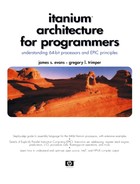Summary
We had several goals in this introductory chapter. First we drew a clear philosophical distinction between computer architectures and their particular implementations. In this view, an architecture should last longer than any one implementation. The marketing names chosen by the computer industry sometimes do not maintain a clear distinction between architecture and implementation.
We discussed the pros and cons of assembly language as a means of programming a computer, explaining that it provides the programmer with the closest view of intrinsic architectural features. Learning assembly language is a good way to learn about computer architecture. We showed what a simple algorithm looks like expressed in assembly language for Itanium architecture, and contrasted that to high-level languages.
This chapter included two mathematical topics. First, the recently standardized prefixes for naming certain powers of two, versus certain powers of ten, for describing computer storage were introduced. We then discussed how computers typically represent signed and unsigned integers, in anticipation of a continuing need for that understanding.
